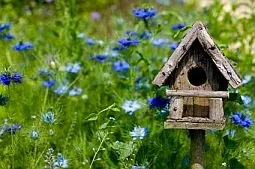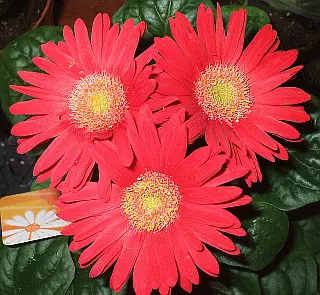In Tune with the Moon.
Michael Littlewood puts the case for consulting the moon when deciding when best to sow, plant and harvest.
In this age and culture of paved roads and streetlights, cars with air conditioning, houses with central heating, and food from supermarkets, it is easy to forget to look up and acknowledge our relationship to the sun, the moon and the stars. Our dependence on the sun is obvious and straightforward: it gives us our days and nights, the warmth of the air, the light in our skies, and the turning of the seasons. Without it, plants would not be able to survive and grow, and there would be no food for man or beast.
But also in the sky is another large celestial body, the moon, moving gently around the earth as the earth spins around the sun. The moon is relatively large and heavy, and its gravitational force affects all that there is on Earth. The most obvious effect of its gravitational pull is that of the tides, the moon moving all the water on the surface of the earth. But all animals and plants consist of about 85 per cent water, so they are also strongly affected by the moon.
Whole civilisations have based their agriculture around planting by the moon, but much of modern gardening is undertaken without any understanding of the moon, the planets and the stars. Gardening with the moon has occurred in various guises and according to different traditions which have been passed down through the centuries, and by drawing on these and acknowledging the influence of the moon we can start to work in harmony with all that is around us.
The moon month – a period of approximately 28 days (a “moonth”) – is made up of four quarters. These are referred to as the first, second, third and fourth quarter. (In diaries they are referred to as “new moon”, “first quarter”, “full moon” and “fourth quarter”.) On the first day of the first quarter (new moon), the strength of the moon’s gravitational pull upon Earth is at its weakest. The pull increases as the first quarter develops into and becomes the second quarter. At the end of the second quarter (full moon) and the start of the third, the gravitational pull is at its strongest. When the third quarter begins, the strength of the pull starts to reduce. It goes on reducing through the third quarter and then through the fourth quarter. At the end of the fourth quarter, the pull is once again at its weakest.
The earth’s water table responds to this phenomenon. It rises as the strength of the moon’s gravitational pull increases, and falls back as the strength decreases. As the water table rises, it exerts an upward pressure. This causes the moisture beneath our garden soil to rise. This, in turn, results in an increased moisture content at the level where gardeners work. As the water table falls back, the pressure decreases and the topsoil’s moisture content reduces. This unfailing act of nature – which is of greatest significance during summer’s diminished rainfall and increased activity in the garden – can be of help to the aware gardener in a number of ways.
As gardening with the sun includes working with the seasons, so gardening with the moon includes working with the phases of the moon and its relationship to the planets and stars. As most plants do most of their growing in the spring and summer, so much of the upward growth, germination of seeds, and creating of leaves and flowers, occurs during a waxing moon. As most plants produce fruit and seed in the autumn, and go through some form of “death” for the winter, so much of the downward growth, creating roots and establishing plants, happens on a waning and new moon.
Decisions about when to sow, plant and harvest should therefore take lunar cycles into account. This is especially relevant when the moon is waxing and in the 48 hours before fullness, because crops sown at this time will in all cases grow better and faster. As the moon waxes and water and nutrients are drawn upwards, this helps plants that produce their most valuable parts above ground, such as fruiting crops and flowers. When the moon wanes, water and nutrients move downwards, so this is a favourable time for root crops.
A lunar calendar also relates the moon’s position in the sky to the twelve constellations of the zodiac. Over the course of a lunar month, the moon moves through all the constellations, remaining in each for two or three days. Each constellation is particularly associated with one element: water, fire, air or earth, which are represented in plants by root, flower, fruit and leaf. These associations indicate which days are most appropriate for work with root, flower, fruit and leaf plants. A lunar calendar will also indicate the optimum times for sowing, planting, pruning and harvesting.
To understand these patterns, known and worked with for thousands of years, is to understand the garden and its relationship to the earth and the skies. Working with the patterns of the moon as well as the sun offers us a simple way of making the most of our outdoor space. Planting with the moon results in more reliable germination of seeds, easier and more reliable transplanting of seedlings, and better, healthier crops, whether of fruit, vegetables, herbs or flowers.
First principles of lunar gardening
= Always plant when the moon is waxing.
= The influence of the moon is greatest when it is full.
= Never plant during a full moon eclipse.
= Try to sow or plant when the moon is in a zodiac sign corresponding to that crop.
= A bad aspect between Saturn and the moon will damage a seed’s effectiveness, and a good aspect will enhance it.
Feeding by the moon
A bonus of moon gardening is that if fertiliser is applied at the correct moon time, it can be reduced by as much as 50 per cent of the recommended volume or weight. As the water table recedes during the moon’s final phase, it draws to a deeper depth any fertiliser that is applied at that time.
Dig and add manure and fertilisers to the soil at the start of the moon’s fourth quarter – on the first day, ideally, or as close as possible to that time. The falling water table releases pressure on the dug soil and encourages a more thorough and deeper absorption of additives. A consequent further bonus is a reduction in the build-up of the chemicals that are now known to cause problems for both wildlife and mankind.
Michael Littlewood is a landscape designer and the author of many gardening publications including The Organic Gardener’s Handbook Only £11.95 plus P&P.
Also available: A Guide to Gardening by the Moon (£9.95 plus £2.55 P&P)
A Guide to Companion Planting (£9.95 plus £2.55 P&P)
Vegetable Growing Guide, Vegetable Planning Chart, Companion Planting Chart, Gardener’s Monthly Reminder
Gardening by the Moon Calendar
Michael Littlewood’s beautifully illustrated full-colour charts, guides and calendars provide a wealth of information for your gardening year – and they make perfect gifts for any keen gardener. All are produced by an environmentally friendly printing process, using paper from sustainable sources, and are packed in biodegradable tubes.
To order any of the above, visit www.ecodesignscape.co.uk








